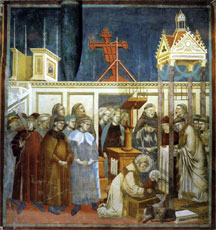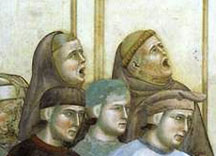Part 1 in the series: More Christmas Carol Surprises
Permalink for this post / Permalink for this series
Three years ago I did a blog series called Christmas Carol Surprises. As we draw near to Christmas, I thought it might be good to revisit and add to this series. What follows will be an edited and expanded version of my earlier material, with quite a bit of new stuff added in.
First, my confession: I love Christmas carols. I love the way they sound. I love the memories they evoke. And, in many cases, I love the truths they celebrate. So in the next few days I’m going to do a short series on Christmas carols. I promise that it will be informative, fun, and maybe a bit inspirational too.
There are limits to my love of Christmas carols, however. I don’t like hearing them in stores in October, or even most of November. It isn’t just the commercialization of Christmas that bugs me. Rather, listening to Christmas carols for three months dilutes their specialness. So, though I love Christmas carols, I should add that I love them in December, with a bit of overlap into November (after Thanksgiving) and January (until Epiphany on January 6).
Christmas Carol Fun
Do you like Christmas carols? Do you think you know Christmas carols pretty well? Then I have a website for you. FunTrivia.com, which claims to be the “world’s largest, best, and most fun trivia website” has a great collection of Christmas music trivia quizzes. My favorite is “Christmas Carol Trivia: Sacred Carols,” but there are many more. Warning: You can spend a lot of time at this site if you’re not careful.
Ancient Christian Songs
Early in the second century A.D. the Roman governor of Pontus and Bithynia (northern Turkey) wrote letters to the Emperor Trajan. In one of these letters he described the actions of some troublesome (from Pliny’s point of view) Christians: “They asserted, however, that the sum and substance of their fault or error had been that they were accustomed to meet on a fixed day before dawn and sing responsively a hymn to Christ as to a god, . . .” This is one of the earliest references to Christian singing.
Many scholars believe that early Christian songs are quoted in the New Testament letters of Paul. One of these, in Philippians 2:5-11, includes the following lyrics:
[Christ Jesus] who, though he was in the form of God,
did not regard equality with God
as something to be exploited,
but emptied himself,
taking the form of a slave,
being born in human likeness.
And being found in human form,
he humbled himself
and became obedient to the point of death—
even death on a cross. (2:5-8)
Though we wouldn’t call this a Christmas carol, it does focus on the birth of Jesus and His death. It sees this birth through the lens of theology rather than narrative, however. Some scholars view this song as a theological statement informed by the early stories of Jesus’s birth. This is possible, but cannot be proven. Of course the main point of this “song” isn’t the birth of Jesus, but His death.
Carols as Forbidden Folk Music
Although the church did include religious singing in its liturgy surrounding the birth of Jesus, carols were written in a more popular idiom. The word “carol” originally described a song that had verses and a repeating chorus. It was frequently sung in the context of folk dancing (circle dancing). Most of the Christmas carols in the Middle Ages were secular or pagan in origin, and thus they were not popular with religious officials. On more than one occasion, as early as the 7th century and as late as the 16th century, Roman Catholic councils attempted to ban Christmas carols altogether. Only the reverent sounds of sacred chant were deemed appropriate for memorializing the birth of Jesus.
My own theological ancestors, the Reformed Puritans of Britain, attempted to get rid, not only of Christmas carols, but also of Christmas itself. They attempted to “purify” the church of both secular and Roman Catholic elements. When they were in power in Britain in the middle of the 17th century, the Puritans actually succeeded in making the celebration of Christmas illegal. No carols, no fun, no Christmas! The earliest Europeans in America, coming from English Puritan stock, did not celebrate Christmas, and in fact made a point of not doing so. In fairness to these folk, however, we should understand that the secular and pagan celebrations of Christmas were often filled with drunken excess, rather more like Mardi Gras in New Orleans than most secular Christmas celebrations today (except, perhaps, for office parties run amuck).
The Influence of St. Francis
 Many historians credit St. Francis of Assisi with vitalizing the Christian celebration of the birth of Christ. Early in the 13th century he created the first (or one of the first and surely the most famous) life-sized Nativity scenes, complete with live animals, a real baby in the manger, and a worship service. This service included the singing of lively, joyful Christmas music – something that was virtually unknown up to this time. Francis forged the combination of genuine love for Christ with genuine celebration, which almost always includes joyful music. (Photo: This painting by Giotto (c. 1300) depicts the “crib” of St. Francis. Notice the singers in the back row. In the photo below, the singers in the back row are easier to see in this detail. Notice the vigor of their singing! They’re singing joyous carols, indeed.)
Many historians credit St. Francis of Assisi with vitalizing the Christian celebration of the birth of Christ. Early in the 13th century he created the first (or one of the first and surely the most famous) life-sized Nativity scenes, complete with live animals, a real baby in the manger, and a worship service. This service included the singing of lively, joyful Christmas music – something that was virtually unknown up to this time. Francis forged the combination of genuine love for Christ with genuine celebration, which almost always includes joyful music. (Photo: This painting by Giotto (c. 1300) depicts the “crib” of St. Francis. Notice the singers in the back row. In the photo below, the singers in the back row are easier to see in this detail. Notice the vigor of their singing! They’re singing joyous carols, indeed.)
The Revival of Christmas and Christmas Carols

Even though the celebration of Christmas was technically legal from the late 17th century and onward, the holiday was largely ignored by the English. Continental Europeans were more apt to celebrate Christmas with a combination of secular, pagan, and Christian traditions. It’s from the Continent that we get, for example, the traditions of Christmas trees and Santa Claus. In 19th-century England, however, Christmas was largely forgotten, a victim of religious disinterest and industrial urbanization.
Yet in the Victorian Age new champions of Christmas emerged, among them Clement Moore (who wrote the poem we know as “‘Twas the Night Before Christmas” in 1822) and Charles Dickens (who wrote several Christmas stories including, of course, “A Christmas Carol” in 1843”). Under the influence of these and other writers, Christmas became a popular celebration, a day for feasting and family. During this same period of time many of our favorite carols were either written or published for the first time. (I’ve written quite extensively on Dickens and Christmas.)
Resources
For more information about Christmas carols, see The New Oxford Book of Carols. A fantastic online source of information is The Hymns and Carols of Christmas. Much of what I have summarized in this post comes from these two sources.
No comments:
Post a Comment